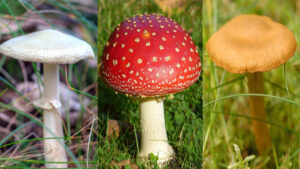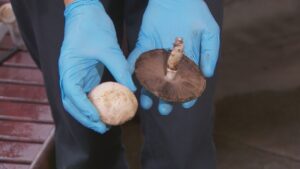Notable Elements
Importance of Research and Education: Gain knowledge through various resources to accurately identify edible and poisonous mushrooms.
Professional Guidance is Crucial: Leverage the expertise of experienced mushroom hunters or mycologists for accurate identification.
Beware of Deadly Look-alikes: Understand and recognize poisonous species that closely resemble edible ones to avoid fatal mistakes.
Study Mushroom Anatomy: Learn about the key anatomical features of mushrooms, such as cap shape, gills, and stem, which are essential for correct identification.
Habitat Observation: Note the mushroom’s growing environment, as it can provide significant clues about its identity.
Start with Easy Edibles: Begin your foraging experience with easily identifiable edible mushrooms to build a strong foundation.
Caution with Consumption: Start with small amounts when trying new wild mushrooms and watch for adverse reactions.
Utilize Multiple Identification Methods: Combine information from different sources for a more accurate identification.
Avoid Single-Characteristic Reliance: Do not depend on one feature for identification; consider all characteristics collectively.
Practice Ethical Foraging: Harvest mushrooms responsibly to ensure sustainability and ecological balance.
Awareness of Poisonous Mushroom Effects: Know the potential risks and seek immediate medical attention in case of suspected poisoning.
Necessity of Mushroom Identification: Essential for safety, culinary enjoyment, ecological understanding, medicinal use, and scientific research.
Introduction
Despite mushroom hunting being a fun and rewarding hobby, it is crucial to identify mushrooms, particularly edible species and poisonous ones. While there are numerous safe and delicious fungi in the wild, there are also deadly ones that can cause severe illness or even be life-threatening if ingested. Therefore, it is important to educate oneself on the key characteristics that distinguish edible mushrooms from their potentially harmful counterparts.

Differences between edible and poisonous mushrooms.
- Research and Education: The first step to becoming proficient in mushroom identification is through extensive research and education. There is a wide variety of field guides, websites, and books available that can provide valuable information about different mushroom species. Familiarize yourself with the specific characteristics and habitats of edible and poisonous mushrooms to differentiate between them accurately.
- Seek Professional Guidance: If you are starting mushroom identification, it is recommended to seek guidance from experienced mushroom hunters or mycologists. Many local mycological societies offer workshops, forays, and classes where you can learn firsthand from knowledgeable individuals. Professional mushroom hunters can point out various species, explain key differences, and teach you safe mushroom hunting practices.
- Know the Deadly Look-alikes: One crucial aspect of mushroom identification is recognizing poisonous species that may closely resemble edible varieties. For example, the Death Cap (Amanita phalloides) is responsible for major mushroom-related fatalities worldwide, and it can easily be mistaken for an edible mushroom due to its initial resemblance to some edible Amanita species. Learning to distinguish these look-alikes is vital for your safety.
- Study Mushroom Anatomy: Understanding the anatomy of mushrooms is essential for identification purposes. Key features to focus on include the cap shape, gills or pores on the underside, stem structure, and presence or absence of a ring or volva (a remnant of the universal veil). Unique characteristics like spore color, bruising reactions, and odor can also provide significant clues for identification.
- Observe the Habitat: Mushrooms are highly dependent on their specific habitats for growth. By taking note of where you find the mushrooms, whether on soil, wood, or near tree species, you can narrow down the possibilities of their identity. Certain types of mushrooms are more likely to be edible and safe, while others growing in toxic environments may indicate their potentially poisonous nature.
- Start with Easy-to-Identify Edibles: As a beginner, it is wise to focus on foraging for easily identifiable edible mushrooms. Some common and relatively easy-to-identify edible mushrooms include the Morel (Morchella spp.), Chanterelle (Cantharellus cibarius), and King Bolete (Boletus edulis). Becoming well-versed in these mushrooms will provide a solid foundation for further exploration.
- Be Cautious and Start Slow: When consuming wild mushrooms for the first time, it is crucial to exercise caution and start with small quantities. Even if you are confident about the identification, some individuals may still be allergic or sensitive to certain mushrooms, even those considered safe and edible by most. Consuming small portions and waiting for adverse reactions before increasing the quantity will help you avoid potential problems.
- Use Multiple Identification Tools: Using multiple identification tools will increase your certainty when identifying mushrooms. Combine information from field guides, websites, and expert opinions to cross-reference and validate your identification. This approach will help reduce the chances of misidentification and increase your confidence in distinguishing between edible and poisonous mushrooms.
- Never Rely on a Single Characteristic: It is important to note that relying on a single characteristic to determine the edibility or toxicity of a mushroom can be risky. For example, the myth that mushrooms are safe to eat if they turn silver when cut with a silver utensil is untrue. Always consider the collective combination of features, including color, shape, odor, and habitat, to ensure accurate identification.
- Practice Ethical Foraging: Lastly, it is essential to practice ethical foraging by not depleting mushroom populations unnecessarily. When you find edible mushrooms, harvest them responsibly, taking what you need and leaving the rest to continue the life cycle and provide habitat for other organisms. Our natural ecosystems depend on the sustainability of mushroom populations.
Effect Of ingesting poisonous mushrooms
Poisonous mushrooms are fungi that contain toxins that can be harmful or even fatal if ingested. There are thousands of known species of mushrooms, and approximately 100 of them are highly toxic to humans. The toxins found in poisonous mushrooms can vary depending on the species. Some toxins affect the central nervous system, causing symptoms such as nausea, vomiting, dizziness, hallucinations, seizures, or even coma. Other toxins can damage the liver, leading to liver failure.

It is important to note that poisonous mushrooms can sometimes resemble edible mushrooms, making it difficult for non-experts to distinguish between them. Therefore, it is necessary to be aware of mushroom identification before consuming wild mushrooms.
Ingesting poisonous mushrooms can be life-threatening, and immediate medical attention is required if someone suspects mushroom poisoning. Treatment typically involves supportive care and, in some cases, specific antidotes.
To prevent accidental poisoning, consume mushrooms from trusted sources, such as grocery stores or farmers’ markets, and avoid eating wild mushrooms unless you are an experienced mushroom forager. Additionally, educating oneself about the specific types of toxic mushrooms in your region can help reduce the risk of accidental ingestion.
Also Read : Exploring Different Strains of Magic Mushrooms for Wellness
Why mushroom identification is necessary?
Mushroom identification is necessary for several reasons:
- Safety: Some mushrooms can be toxic or hallucinogenic if ingested. Accurate identification helps avoid incorrect consumption, which can lead to severe illness or even death.
- Culinary purposes: Knowing which mushrooms are edible allows for the safe preparation and consumption of varied delicious dishes. Mushroom identification helps identify the ones suitable for culinary use.
- Ecological significance: Mushrooms play a vital role in ecosystems as decomposers, symbiotic partners with plants, and nutrient recyclers. Identification helps in understanding their ecological role and studying their distribution and abundance.
- Medicinal uses: Certain mushrooms possess medicinal properties, traditional and alternative medicines. Recognizing them helps in utilizing their potential health benefits.
- Scientific research: Determining mushrooms is vital for documenting and studying fungal biodiversity. This information helps scientists understand the interplay between fungi, plants, and animals, contributing to ecological research and conservation efforts.
The Takeaway
In conclusion, mushroom identification is a skill that requires time, practice, and a solid understanding of the various features that set edible mushrooms apart from their poisonous counterparts.
By investing in research, education, and learning from experienced individuals, you can become proficient in distinguishing between safe and potentially harmful fungi.
Always prioritize safety and approach mushroom hunting with caution and respect for the environment. Enjoy the adventure of mushroom identification, but most importantly, prioritize your well-being.

Hi! I’m Jacob Hawthorne, a passionate medical student dedicated to exploring the fascinating world of psychedelics, particularly magic mushrooms (commonly known as shrooms). With a deep interest in their therapeutic potential and profound effects on the human mind, I aim to provide accurate and evidence-based information about shrooms in the Canadian context.

